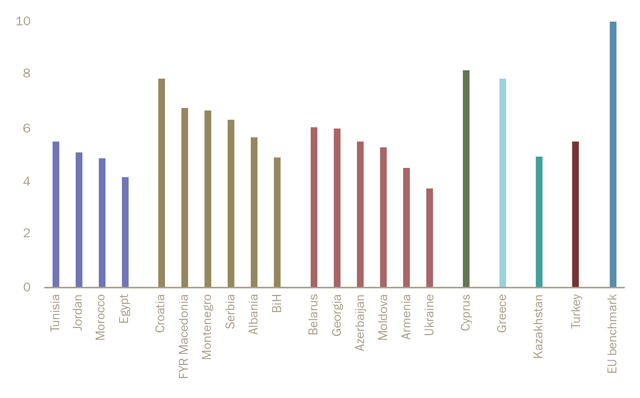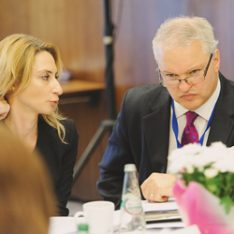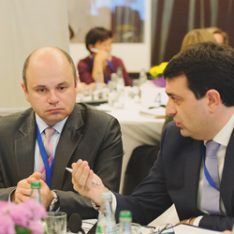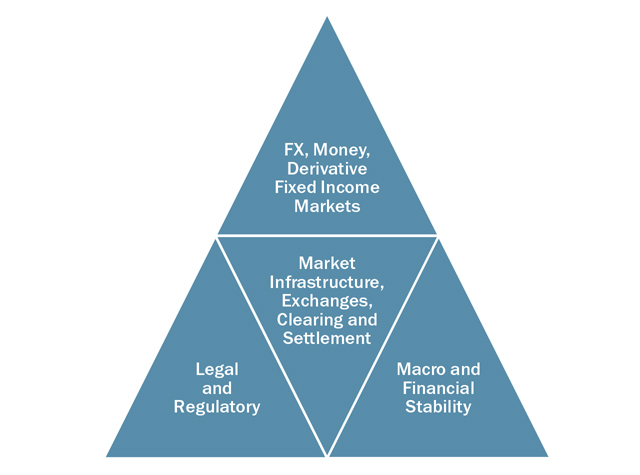In October 2016, the EBRD and the Ministry of Justice of Belarus jointly held a forum in Minsk on commercial mediation in eastern Europe and Central Asia. The event brought together more than 50 senior government officials, judges, mediation practitioners and academics from EBRD countries of operations and beyond to discuss ways of developing and promoting the use of commercial mediation – whereby a neutral third party assists disputing parties in resolving conflicts through negotiation – in the Bank’s region of investment
Kim O’Sullivan, Senior Counsel in the Legal Transition Programme, specialises in legal and regulatory reform that supports, among other things, the use of alternative dispute resolution (ADR) mechanisms, including commercial mediation. She led the EBRD’s involvement in organising the forum, which drew high-level representatives from the governments of Armenia, Azerbaijan, Belarus, Georgia, Kazakhstan, the Kyrgyz Republic, Moldova, Mongolia, Russia, Tajikistan and Ukraine. In this interview, Kim talks about how commercial mediation can help the EBRD region and the challenges associated with making its use more widespread.
What are the benefits of commercial mediation?
They are numerous. First, mediation is very flexible: there are far more outcomes possible through mediation than there are awards that can be made by a court. Courts have a limited range of remedies and awards at their disposal, whereas mediation offers the freedom to find an outcome that benefits all parties. Mediation also gives parties ultimate control over the terms of the resolution and over the decision whether or not to settle – they can even walk away from the process if they are dissatisfied with it before the resolution is agreed. You do not have this in a court process where the judge decides how the dispute is settled.
Moreover, court hearings are generally open to the public but mediation is conducted confidentially, which is important for commercially sensitive matters. This means that the parties can be much more open with the mediator about their true position. As a result the mediator can help the parties bridge the gap between the two sides more effectively, instead of seeking a solution based on the parties’ public statements, which may be far removed from reality. An important confidentiality safeguard resides in the fact that the mediator is prevented from bringing up any statements made during the mediation process in the course of any subsequent litigation or dispute resolution.
Mediation is not focused on the parties’ respective responsibility for the state of affairs in which they find themselves. A mediator, whether court-affiliated or independent, does not give his or her opinion on the facts of the matter or on who is to blame but instead tries to bring the parties to a common position by asking questions.
Another very significant advantage of mediation is that it is quicker and cheaper than going to court. It frees up sums that businesses might otherwise have earmarked for litigation and allows them to invest that money in more economically productive activities. So the presence of a robust commercial mediation system enhances the attractiveness of a country to foreign investors who will have confidence that they will be able to make the best use of their resources.
Overall, the less adversarial nature of the process and its emphasis on mutually agreeable outcomes means that it is a preferable option for parties with a commercial relationship that they wish to maintain, beyond the matter under dispute. With a court case, however, there is a real danger of the commercial relationship sustaining irreparable damage.
Beyond the benefits to the parties in dispute, what wider advantages does commercial mediation bring?
The use of mediation means that fewer disputes go to court, which reduces the caseloads that judges have to deal with and increases the overall efficiency of the judicial system.
Another point to consider is that many female entrepreneurs find mediation to be a more accessible form of dispute resolution than a court case. This is because the parties can tailor the mediation process to their timetables, whereas court cases involve hearings and sessions at times set by the court, regardless of any commitments the parties might have, such as childcare duties. As women in the EBRD region and elsewhere still carry most of the burden of childcare, the flexibility of the commercial mediation system will be particularly attractive to them.
Also, whereas a large proportion of judges in the EBRD region and beyond are men, a relatively high percentage of mediators are women. So the more widespread use of mediation in a country will likely contribute to the greater involvement of women in that country’s dispute resolution system. And I think most people would agree that it is desirable – socially and economically – for both genders to be fairly represented in any profession or sector.
What did the event in Minsk set out to achieve?
The use of commercial mediation is very limited in the EBRD’s countries of operations – although they are by no means exceptional in this regard as mediation remains a relatively new concept in many parts of the world. Where it has been introduced, it has been welcomed by governments, businesses and non-governmental organisations (NGOs) as a very positive development.
The forum in Minsk sought to stimulate wider use of mediation in the EBRD region by bringing experts from various countries, including Serbia and the United Kingdom (UK), to share their knowledge and expertise with high-level officials from 11 of the Bank’s countries of operations. Some of our countries are at the beginning of the learning curve regarding mediation, while others are more advanced, but the region as a whole has a lot of potential for increased use of this form of dispute resolution.
It is very important to say that there is no “one size fits all” version of commercial mediation – each country has to adopt the mediation system that best fits in with its particular legislative framework, whatever stage of development that may be at. But it was still very helpful for participants to exchange their experiences and their ideas about how mediation could be implemented.
As we followed the “Chatham House rules” – meaning discussions held at the event can be referred to outside the forum but without any attribution of quotes or comments to individual speakers – there was a great deal of openness in our conversations. It was great to have people take part from such a wide range of backgrounds and from very senior positions in government administrations. Plus there were many academics who brought a very valuable perspective to the topic.
What are the main obstacles to the wider use of commercial mediation in the EBRD region?
Some countries do not have a law on mediation and need to adopt one, while others do have relevant legislation but in some cases this needs improving. There is also a general misunderstanding in the region as to the nature of commercial mediation. For example, the confidential aspect of the process and the fact that mediators remain neutral may not be widely known.
There is also a common misperception that an agreement reached through mediation cannot be enforced in a satisfactory manner. It is very important that laws on mediation incorporate obligations requiring enforcement agencies to uphold any mediation awards. People often think that, even if a mediator resolves a dispute, the award is unlikely to be enforced, but well-drafted laws will ensure mediation agreements have full legal effect once they have been signed by the parties involved. For example, laws could allow notaries to register mediation agreements so that they enjoy the same level of recognition as a judicial decision.
Another challenge is the lack of government commitment to the greater use of mediation. Administrations in the region could demonstrate their commitment by taking a mediation pledge or by attaching certain conditions to their procurement contracts. In the UK, for example, the government declared in 2011 that any contract to which it was a party would feature a clause obliging both sides to try mediation before taking any disputes to court. This was very helpful in increasing the use of mediation in the UK and it would be great if governments from our region could do something similar.
What concrete results emerged from the forum?
As I said before, the main aim of the event was to share knowledge and experience rather than decide on any immediate action. Nevertheless, the Ministry of Justice of Azerbaijan got in touch with us after the forum to discuss a possible technical cooperation (TC) programme focused on increasing the use of mediation in that country. We also had a lot of interest from the Georgian representatives we met at the event in how LTP could help judicial reform in Georgia.
The EBRD is already engaged in TC projects promoting the use of mediation in Moldova, Mongolia and Serbia. The UK’s Department for International Development is funding the projects in Moldova and Serbia and LTP is working with the Bank’s Investment Climate and Governance Initiative on these programmes. We are looking at further possible projects in the Kyrgyz Republic and Tajikistan and are involved in policy dialogue on this topic in Jordan, Tunisia and Ukraine. Lastly, Armenia has already offered to co-host the next forum on commercial mediation with the EBRD.
You worked with British mediation expert Bill Marsh on preparing the forum and he facilitated the roundtable discussions. Why did you decide to work with Bill?
Bill is one of Europe’s most experienced mediators. He has been at the forefront of resolving very complex disputes for over 25 years and has conducted thousands of mediations with governments, individuals and NGOs, including within our countries of operations. He is highly respected within the field, knows our region well and overall was an ideal person for us to work with. As well as facilitating discussions over the one-and-a-half day event, he helped us tailor what everyone found to be a very successful forum programme. So we were very glad to have him on board.
















































